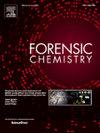非专业人员观察一维气相色谱和综合二维气相色谱输出的色谱差异
IF 2.6
3区 医学
Q2 CHEMISTRY, ANALYTICAL
引用次数: 0
摘要
在法医调查中,色谱法被用来描述样品成分的特征,提供化学模式与已知参照物进行比较,这通常会呈现给没有受过分析化学专业培训的人。综合二维气相色谱法(GC×GC)最近在法医研究中非常流行,用于分析火灾残骸样本、毒品、化学威胁、人体遗骸检测等样本。法医学研究中经常会开发出新的方法,这对我们的观点提出了挑战,因为通过科学交流传达的信息可能会越来越复杂。本研究调查了个人观察非色谱照片、一维气相色谱(GC)色谱图和综合二维气相色谱(GC×GC)等高线图的图像差异的能力。目的是以照片为对照,确定在观察气相色谱色谱图与气相色谱×气相色谱等值线图时,两种输出结果之间的比较观察是有利还是有碍。参与者表示,在所有类别中发现成对图像之间的差异的难度都很低。他们在指出两幅图像可区分或不可区分方面得分很高,而对照图像与每个类别之间没有显著差异。这些结果证明,与传统的一维技术相比,GC×GC 输出可以在专家证词中使用,而不会遇到挑战。正在进行的研究应避免关于 GC×GC 可能会促进或阻碍陪审员理解的说法,因为目前的结果并未显示出明显的益处或弊端。还需要进行更多的研究,以更好地理解技术解释如何帮助专家证人作证,从而更好地评估这种日益普遍的技术将如何适应未来的法医办案机会。本文章由计算机程序翻译,如有差异,请以英文原文为准。

Observation of chromatographic differences by non-specialist viewers for one-dimensional gas chromatography and comprehensive two-dimensional gas chromatography output
In the context of forensic investigations, chromatography is used to characterize a sample’s components, providing a chemical pattern to compare with known references which is often presented to individuals without specialized training in analytical chemistry. Comprehensive two-dimensional gas chromatography (GC×GC) has recently become popular in forensic research for analyzing samples such as fire debris samples, drugs, chemical threats, human remains detection, and more. New methods are developed in forensic research regularly, which challenge our view of what may be increasingly complex to convey through scientific communication. This study investigated individuals’ ability to observe differences in images for non-chromatographic photographs, one-dimensional gas chromatography (GC) chromatograms, and comprehensive two-dimensional gas chromatography (GC×GC) contour plots. The goal was to identify whether comparative observations between two outputs were facilitated or hindered when observing GC chromatograms compared to GC×GC contour plots, using photographs as a control. Participants indicated low difficulty in finding differences between pairs of images in all categories. They scored highly at indicating when two images were distinguishable or indistinguishable, with no significant difference between control images and each category. These results support that GC×GC output can be implemented in expert testimony without challenges over traditional one-dimensional techniques. Ongoing research should avoid statements that GC×GC may facilitate or hinder juror comprehension, as the results currently indicate no significant benefit or drawback. Additional research is needed to improve understanding of how technique explanation could aid expert witness testimony to better evaluate how this increasingly common technique will fit into future forensic casework opportunities.
求助全文
通过发布文献求助,成功后即可免费获取论文全文。
去求助
来源期刊

Forensic Chemistry
CHEMISTRY, ANALYTICAL-
CiteScore
5.70
自引率
14.80%
发文量
65
审稿时长
46 days
期刊介绍:
Forensic Chemistry publishes high quality manuscripts focusing on the theory, research and application of any chemical science to forensic analysis. The scope of the journal includes fundamental advancements that result in a better understanding of the evidentiary significance derived from the physical and chemical analysis of materials. The scope of Forensic Chemistry will also include the application and or development of any molecular and atomic spectrochemical technique, electrochemical techniques, sensors, surface characterization techniques, mass spectrometry, nuclear magnetic resonance, chemometrics and statistics, and separation sciences (e.g. chromatography) that provide insight into the forensic analysis of materials. Evidential topics of interest to the journal include, but are not limited to, fingerprint analysis, drug analysis, ignitable liquid residue analysis, explosives detection and analysis, the characterization and comparison of trace evidence (glass, fibers, paints and polymers, tapes, soils and other materials), ink and paper analysis, gunshot residue analysis, synthetic pathways for drugs, toxicology and the analysis and chemistry associated with the components of fingermarks. The journal is particularly interested in receiving manuscripts that report advances in the forensic interpretation of chemical evidence. Technology Readiness Level: When submitting an article to Forensic Chemistry, all authors will be asked to self-assign a Technology Readiness Level (TRL) to their article. The purpose of the TRL system is to help readers understand the level of maturity of an idea or method, to help track the evolution of readiness of a given technique or method, and to help filter published articles by the expected ease of implementation in an operation setting within a crime lab.
 求助内容:
求助内容: 应助结果提醒方式:
应助结果提醒方式:


